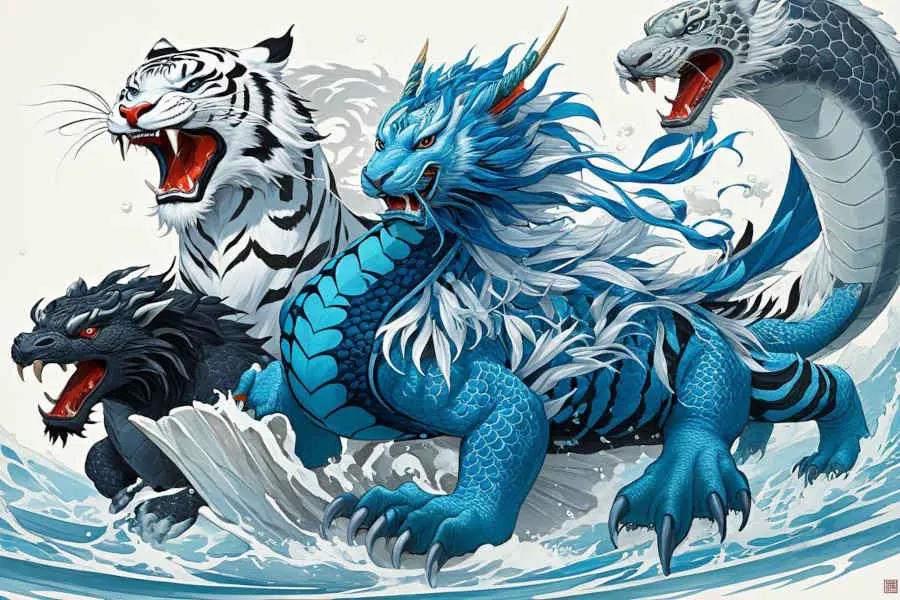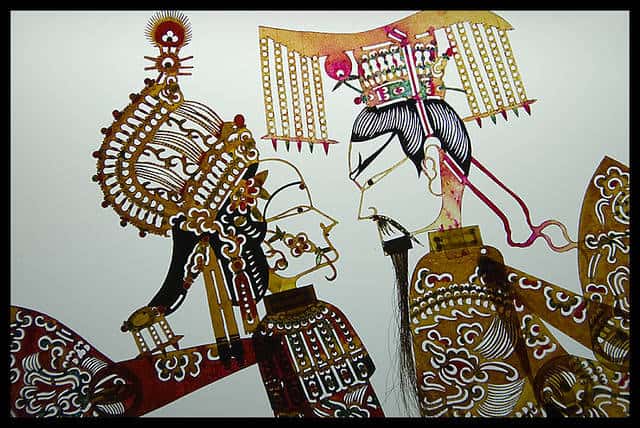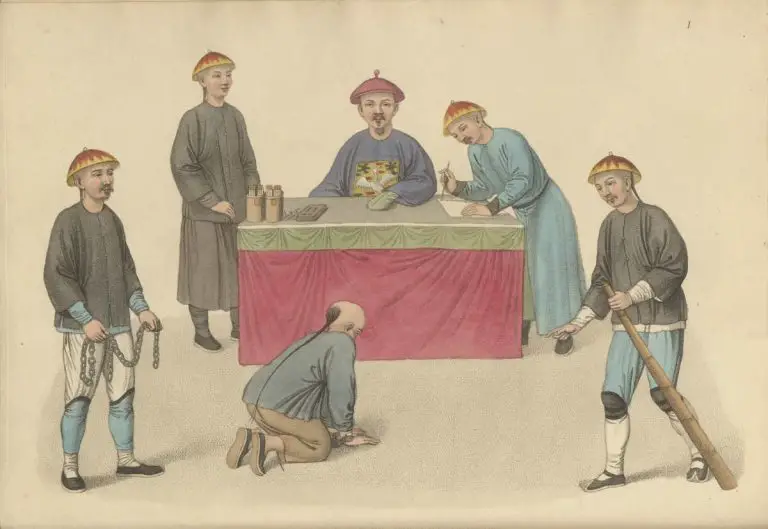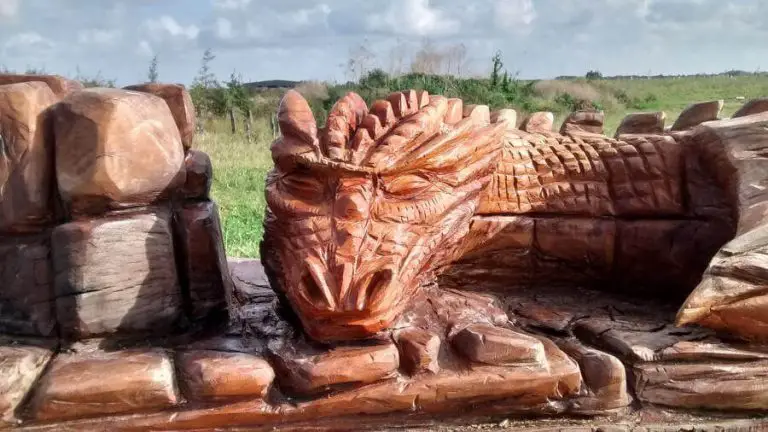Chinese astronomy believes that the ecliptic sky is divided into four equal parts, and each of these sections’ is commanded by a mythological creature, and together they are known as the Four Sacred Animals, Four Celestial Animals, or simply the Four Symbols (四象; Sì Xiàng, literally meaning “four images”).
Each of these sections’ contains 7 mansions, and thus we have 28 mansions in total. These 28 mansions have quite a similar function to the western zodiacal constellations, although these Mansions are commanded by the Moon’s movements rather than the Sun in western astronomy. This system of 28 Mansions allows the Ancient Chinese to determine the time of the year and seasons.
This is why each of the Four Sacred Animals represents a season: the Azure Dragon of the East representing the Spring, the Vermilion Bird (Phoenix) of South for the Summer, White Tiger of the West representing the Autumn, and Black Tortoise of the North for the Winter. Sometimes, the Qilin (representing the Central Midsummer) is also included with the four. Again each, of these animals commanded 7 Mansions (constellations)
History of The Four Sacred Animals
There are so many ancient documents and literature that mentioned the four Celestial Animals, showing how these Four Symbols are deeply ingrained in Chinese culture and Feng Shui. One of the most prominent depictions for the Four Sacred Beasts is in the Shan Hai Jing (山经), an ancient text as old as 4th century BC which is essentially a compilation of mythic geography, with the four heavenly beasts as one of its main focus.
However, there are more recent discoveries that shown how these four entities have been depicted in an ancient neolithic tomb, Xishuipo, in Puyang, Henan, that is believed to be as old as 5,300 BC. In Xishuipo, which was discovered in 1987, we can see a depiction of the Azure Dragon and White Tiger, complete with the directions they represent.
Read also: What are the Four Evil Creatures of Chinese Mythology? – Opens in new tab
The Azure Dragon
The Azure Dragon (simplified Chinese: 青; traditional Chinese: 青, qīnglóng) guard the East direction and is generally depicted as a symbol of protection. In Feng Shui, it is believed that the Azure Dragon is capable of dispelling evil and negative energies as an almighty beast.
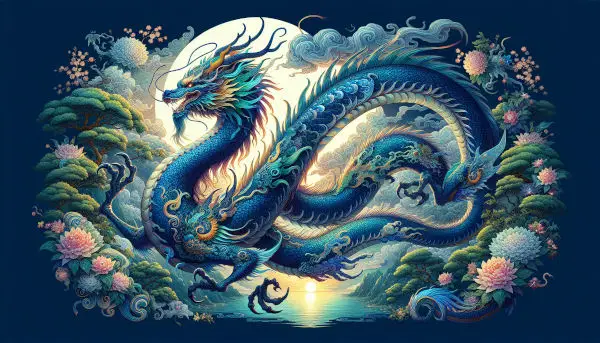
In the Chinese theory of five elements, the Azure dragon represents the wood element and the spring season. It is interesting to note that the other Chinese dragons are more commonly associated with water, but the Azure Dragon is an exception by representing the wood element.
The Dragon is often paired with the Vermilion Bird and the two together represent both conflict and harmony: the yin and yang, the emperor (dragon), and the empress (vermilion bird).
The dragon represents the yang energy, and the color green/blue, and so it is often portrayed to be surrounded by blue water or clouds.
The Azure Dragon commanded the seven mansions in the East: Horn, Neck, Root, Room, Heart, Tail, and Winnowing Basket, and it is believed that when these mansions are joined, they form the shape of a dragon.
The Azure Dragon is considered to be the noblest of all animals and is actually considered the head/leader of the Four Sacred Animals/Four Symbols. Unlike the Western dragons, Chinese dragons, including the Azure Dragon, are believed to be benevolent and just, protector of humans and bringer of good fortune.
The Vermilion Bird
The Vermilion Bird (Chinese: 朱雀; pinyin: zhūquè) commands the South direction, and ancient Chinese astronomy, the Vermilion Bird or Red Bird represent the planet Mars along with seven southern Mansions, which when combined together look like a bird with its wings.

It is also often called the Zhuiniao, and is believed to have a chicken’s head, snake’s neck, swallow’s chin, fish’s tail, and five-color feathers.
Quite obviously the Vermilion Bird also represents the fire element and is often depicted as a flame-covered pheasant.
It is worth noting that the Vermilion Bird is not the Chinese Phoenix or Fenghuang. Instead, the Vermilion Bird is believed to be the ruler of all birds and is widely used as the symbol for the Chinese empress.
The Vermilion Bird represents the summer season, and also symbolizes prosperity and good luck. The seven mansions are Well, Ghosts, Willow, Star, Extended Net, Wings, and Chariot.
The White Tiger
The White Tiger, (Chinese: 虎; pinyin: baíhŭ), is believed to be a terrifying but honorable beast: it eats humans, but also believed to protect people from evil and negative energies. The Baihu is in charge of the West sky and is also the symbol of power, authority, bravery, loyalty, and justice, and in Chinese mythology is often believed as the God of War. This is why we often see the white tiger in the military flag and seal in China.

Painting tigers on gates and doors was actually a custom back in the times of the Han Dynasty (202 BC-AD 220), and this practice is believed to dispel demons and ghosts from households.
The white tiger is thought to be benevolent, and more powerful than the ordinary Chinese tiger. According to Chinese mythology, the tiger’s fur only turns white when it reaches 500 years old, and in ancient China, it is believed that the White Tiger would only appear when the Chinese emperor ruled with absolute virtue when peace reigned throughout China.
White Tiger is often depicted together with Azure Dragon in Feng Shui applications and in arts. For example, in ancient law courts, the Azure Dragon is often depicted on the left, while the White Tiger is depicted on the right.
The White Tiger also represents the autumn season and metal element.
Black Turtle
The Black Turtle (Chinese: 玄武; pinyin: xuánwŭ) commands the North direction and also represents the water element and the winter season.
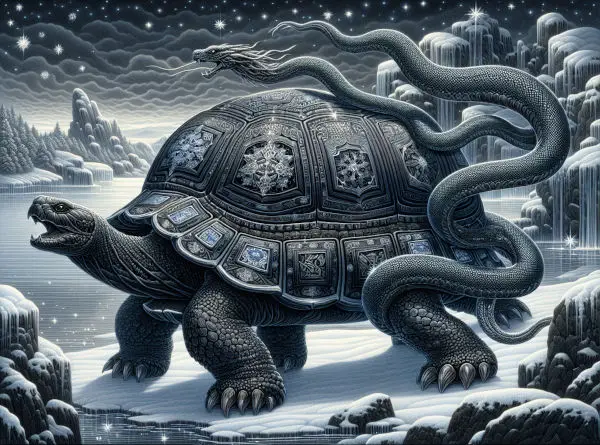
The Black Turtle is depicted as a turtle giving divination, with a black back. It is believed that the Black Turtle could take questions to ancestors in the afterlife and then bring back the answer.
The Xuanwu is also a symbol of longevity.
According to the classic novel, Journey to the West, the Xuanwu was a king of the north with two generals serving under him, the Snake General and Tortoise General, ruling a temple at Wudang Mountains in Hubei province. This is why there are a Snake Mountain and Tortoise Mountain on the opposites sides of a river in Wuhan, Hubei.
This is also why the Black Turtle is often depicted together with a snake, most commonly with the snake coiling around the Turtle’s back.
| Sacred Animal | Element | Season | Direction | Symbolism |
|---|---|---|---|---|
| Azure Dragon (青龙) | Wood | Spring | East | Growth, vitality, renewal |
| Vermilion Bird (朱雀) | Fire | Summer | South | Passion, energy, prosperity |
| White Tiger (白虎) | Metal | Autumn | West | Strength, justice, resilience |
| Black Turtle (玄武) | Water | Winter | North | Wisdom, endurance, introspection |
| Qilin (麒麟) (optional) | Earth | Center | Center | Stability, balance |
Cultural Influence and Modern Symbolism of the Four Celestial Animals
The Four Sacred Animals of Chinese mythology—Azure Dragon, Vermilion Bird, White Tiger, and Black Turtle—extend far beyond their ancient origins, influencing modern culture, art, and even contemporary philosophies. Their timeless symbols of power, protection, and balance continue to shape various aspects of society today, resonating globally. Here’s an expanded exploration of their cultural significance in different domains:
Business and Branding
The symbolism of the Four Sacred Animals is widely adopted in corporate branding and product marketing:
- Luxury Goods: High-end brands often use the Azure Dragon or White Tiger to signify luxury, power, and prestige. The dragon, in particular, is a popular motif in Chinese New Year collections and corporate logos.
- Financial Institutions: Many banks and investment firms incorporate these symbols, especially the Black Turtle, representing stability and longevity.
- Martial Arts Schools: Numerous dojos and Kung Fu schools adopt the Four Sacred Animals as symbols of strength and discipline. Tiger and Dragon motifs often represent balance between power and wisdom.
Fashion and Pop Culture
Fashion designers frequently draw inspiration from the Four Symbols, translating their attributes into contemporary styles:
- Streetwear: The White Tiger and Azure Dragon are commonly used in urban fashion. Brands leverage these symbols for their associations with strength, rebellion, and cultural heritage.
- High Fashion: Runway collections often feature embroidered or printed representations of the Vermilion Bird, symbolizing elegance and vitality.
- Pop Culture: The Four Sacred Animals are recurring themes in anime, video games, and films, symbolizing the characters’ attributes. For example, the Azure Dragon often represents a wise mentor or noble warrior, while the White Tiger may symbolize a fierce rival.
Symbolism in Modern Spiritual Practices
The Four Symbols have been integrated into modern spiritual practices beyond Feng Shui:
- Meditation and Mindfulness: Each animal’s attributes align with specific meditative focuses. For example, practitioners might visualize the Azure Dragon for renewal and courage or the Black Turtle for grounding and resilience.
- Astrology and Horoscopes: Modern Chinese astrology often incorporates the Four Sacred Animals as guides for understanding personality traits and life paths, similar to Western zodiac signs.
- Tattoo Culture: Many people choose tattoos of the Four Sacred Animals for their deep symbolic meanings. The Azure Dragon represents protection and good fortune, while the White Tiger symbolizes strength and courage.
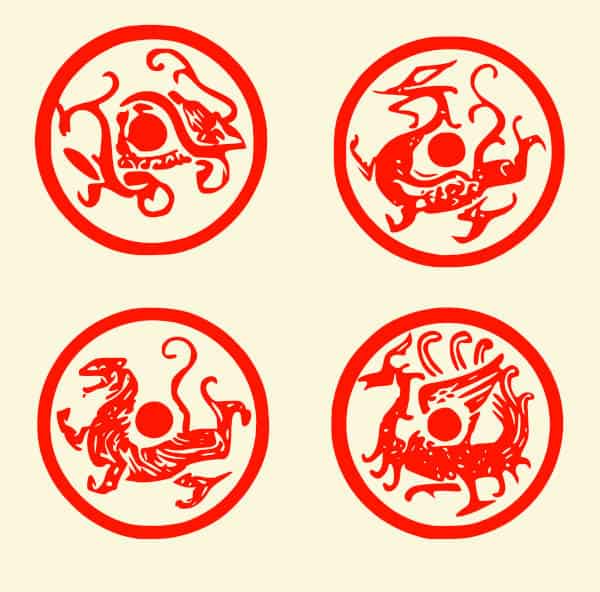
Influence on Education and Literature
The Four Symbols are used in educational settings and literary works to teach about Chinese culture and philosophy:
- Textbooks and Curriculum: In Chinese schools, students learn about the Four Symbols as part of history, mythology, and philosophy courses.
- Contemporary Literature: Authors incorporate these symbols to reflect themes of balance, destiny, and struggle. For example, a novel might use the Black Turtle to represent a character’s journey toward wisdom and endurance.
Global Resonance and Intercultural Adaptations
The universality of the Four Sacred Animals has led to their adoption and reinterpretation in various global contexts:
- Western Occultism: Some Western esoteric traditions incorporate the Four Symbols into their systems, associating them with the elements of air, fire, water, and earth.
- Global Festivals: During Chinese New Year celebrations worldwide, representations of the Four Animals appear in parades and cultural performances, symbolizing protection and prosperity for the coming year.
In essence, the Four Sacred Animals continue to inspire and resonate across diverse fields, blending ancient wisdom with modern relevance. Their timeless symbolism reminds us of the importance of balance, protection, and respect for natural and cosmic forces, offering lessons that are still profoundly relevant in today’s interconnected world.
Related reading: “A Concise Timetable of Feng Shui History“ –Opens in new tab
Feng Shui Applications for The Four Sacred Animals
Azure Dragon Feng Shui Applications
It is believed that the Azure Dragon resides on the left side of the property, and thus homeowners who practice Feng Shui often create gardens (wood element) on the left side of the house to signify the presence of the Azure Dragon. Green plants further emphasize the green/blue color of the noble Azure Dragon.
It is believed to attract wealth, and for households with men as the head of the house and the breadwinners, it is very important to have this left side of the house. If it’s impossible to set up a garden, then you can use a fence as a substitute.
For statue placements, the Azure Dragon should be shorter compared to the Black Turtle, but taller/higher than the White Tiger.
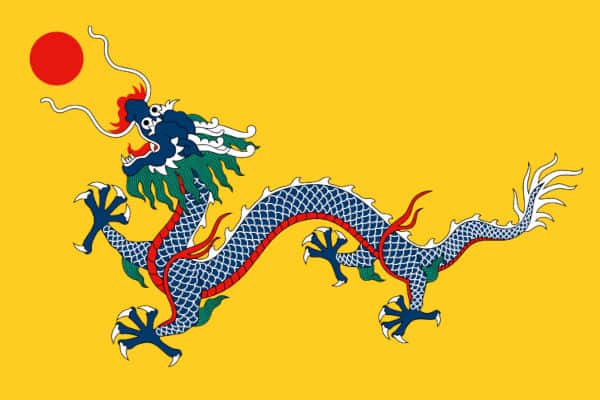
Black Turtle Feng Shui Applications
The Black Turtle guards the back of the house, acting as the pillar of protection for the household, keeping the household safe from evil energy and betrayals.
The classic practice is to have a mountain behind the house to symbolize the presence of the Turtle. However, in modern households, skyscrapers can be an alternative to mountains, or we can also have tall trees as an alternative to serving the purpose.
In general, it’s ideal if the back of the house is sitting in front of a tall structure to signify the presence of the Black Turtle.
Related reading: “Chinese Good Luck Charms To Bring Good Fortune” –Opens in new tab
Vermilion Bird Feng Shui Applications
The Vermilion Bird guards the front of the house, the first area of contact of the house with the energy of the surrounding areas. The Bird protects the house from negative energy and allowing auspicious energy to pass.
The general practice is to have the front of the house flat and low-lying, or you can also create a small hump in front of the house to symbolize the presence of the Vermilion Bird.
White Tiger Feng Shui Applications
The White Tiger guards the right area of the house, representing the feminine (yin) energy while the Dragon on the right represents masculine (yang) energy. Households with women as the leader and the main breadwinner should pay closer attention to this area, as this will be the gatekeeper of your fortune vault.
It’s best to place the tiger statue in a seated position to symbolize calmness and strength. It’s important to keep this area clean and tidy, not to agitate the White Tiger.
If the house is missing its right area (for example if you share a wall with your neighbors), then you can use a fence as an alternative.
Want to learn more about Feng Shui? Take a look at these Courses and Books – Aff.link
Four Celestial Animals – Comparisons with Other Cultures
The concept of Four Sacred Animals representing cardinal directions and cosmic forces is not unique to Chinese mythology. Similar symbols appear in various cultures around the world, reflecting humanity’s shared desire to understand and harmonize with the universe. Here’s an expanded look at how different civilizations incorporate analogous symbols and their meanings:
Japanese Culture: The Shijin (四神)
In Japan, the Four Symbols are known as the Shijin or Four Guardian Beasts. They retain much of the same symbolism as in Chinese mythology but have distinct interpretations in Shinto traditions:
- Seiryū (青龍): The Azure Dragon of the East symbolizes spring and renewal. In Shinto shrines, Seiryū is often depicted guarding sacred spaces, representing protection and prosperity.
- Suzaku (朱雀): The Vermilion Bird of the South represents fire and summer. It is associated with the Phoenix, symbolizing rebirth and eternal life.
- Byakko (白虎): The White Tiger of the West embodies courage and the metal element. In Japanese folklore, it represents warriors and is often invoked for protection in battles.
- Genbu (玄武): The Black Turtle of the North is depicted as a turtle entwined with a serpent, symbolizing water and winter. In some regions, Genbu is considered a deity of longevity and wisdom.
The Shijin are commonly found in Japanese temples, imperial palaces, and cultural festivals. For example, the city of Kyoto is traditionally guarded by these four deities, each linked to specific gates and districts.
Korean Culture: The Sasin (사신, 四神)
In Korean mythology, the Sasin are the Four Heavenly Guardians, and they play a crucial role in geomancy and traditional beliefs:
- Cheongryong (청룡): The Azure Dragon is associated with the East and represents prosperity, good fortune, and protection against evil spirits.
- Jujak (주작): The Vermilion Bird of the South symbolizes warmth, passion, and the Sun’s energy. It also represents cultural refinement and artistic beauty.
- Baekho (백호): The White Tiger represents the West, symbolizing bravery and integrity. In ancient Korea, warriors would invoke Baekho for strength and protection.
- Hyeonmu (현무): The Black Turtle, depicted with a serpent, governs the North and signifies endurance and spiritual strength. It is often linked to ancestral worship and longevity.
These symbols are deeply ingrained in Korean royal architecture and traditional hanbok designs, reflecting their protective and spiritual roles.
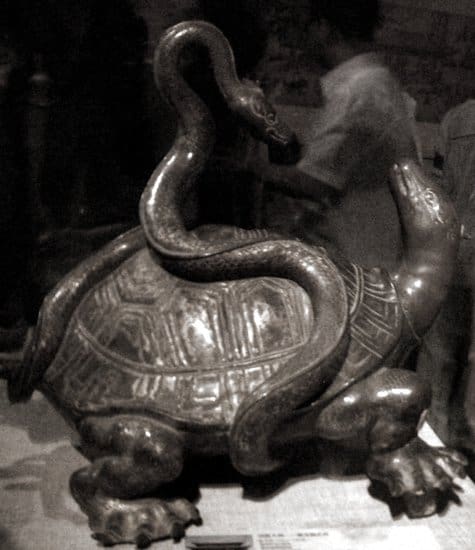
Indian Culture: Lokapalas and Guardians of Directions
In Hinduism and Buddhism, the Lokapalas are the Four Heavenly Kings who guard the cardinal directions, each associated with different elements and virtues:
- Kubera (North): The guardian of wealth and prosperity, associated with the winter season.
- Varuna (West): Protector of the ocean and moral order, symbolizing autumn and the element of water.
- Indra (East): King of the gods and ruler of storms, representing renewal, spring, and the element of air.
- Yama (South): God of death and justice, often linked to the summer season and the fire element.
These deities are frequently depicted in Buddhist temples and serve to protect the dharma (teachings) from evil influences, much like the Four Sacred Animals in Chinese mythology.
Ancient Greek and Roman Mythology
In Greco-Roman culture, four powerful symbols were associated with the cardinal directions and seasons:
- Eagle (East): Linked to Zeus (Jupiter), symbolizing divine authority and the rising Sun.
- Lion (South): Represents strength and passion, often associated with the summer solstice and the constellation Leo.
- Bull (West): Connected to Taurus and the setting Sun, symbolizing fertility and autumn’s harvest.
- Angel (North): Symbolizes purity and protection, often linked to the winter solstice and the celestial realm.
These symbols later influenced Christian art, where the Four Evangelists (Matthew, Mark, Luke, and John) are represented by these creatures.
Native American Traditions
Many Native American tribes also use Four Sacred Animals to represent directions, seasons, and spiritual guides:
- Eagle (East): Represents spiritual enlightenment and the renewal of dawn.
- Wolf (South): Symbolizes loyalty, family, and the warmth of summer.
- Bear (West): Denotes introspection and strength, often linked to autumn and the setting Sun.
- Buffalo (North): A symbol of endurance, wisdom, and winter’s hardships.
In Medicine Wheels, these animals provide guidance and protection, echoing the balance seen in Chinese mythology.
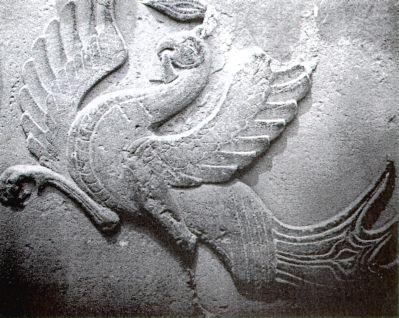
Egyptian Mythology: Guardians of the Cosmos
The ancient Egyptians depicted four protective deities (often with animal forms) linked to the cardinal directions:
- Horus (East): The falcon-headed god represents rebirth and the rising Sun.
- Sekhmet (South): The lioness goddess symbolizes fierce protection and the scorching heat of summer.
- Osiris (West): God of the afterlife, associated with the setting Sun and the cycle of life and death.
- Thoth (North): The ibis-headed god of wisdom, connected to the cold, mysterious night sky.
These cross-cultural connections highlight the universality of using symbolic animals to represent the forces of nature and the cosmos, underscoring a shared human quest to understand and harmonize with the world.
The Four Symbols in Popular Media
The Four Sacred Animals frequently appear in various forms of popular media, reflecting their enduring influence and rich cultural symbolism. Their representations often carry the same meanings rooted in ancient Chinese mythology, but they are adapted creatively across different contexts. Here’s a deeper look into their presence in literature, television, gaming, and other media forms:
Literature and Folklore
The Four Symbols are central to many classic Chinese stories, where they often represent the balance of natural forces or serve as divine protectors:
- Journey to the West (西游记): The Black Turtle, known as Xuanwu, appears as a powerful figure embodying wisdom and divine authority. The tale mentions Xuanwu’s temple, which plays a role in protecting the northern territories.
- Romance of the Three Kingdoms (三国演义): References to the Four Symbols can be found in military strategies, where the animals symbolize different approaches to war and leadership.
- Shan Hai Jing (山海经): This ancient text compiles myths about the world’s geography, including detailed stories of the Four Sacred Beasts guarding their respective directions.
Television and Film
In Chinese historical dramas and fantasy series, the Four Sacred Animals often appear as guardians or spiritual guides:
- The Untamed (陈情令): The Four Symbols are indirectly referenced through the protective spiritual formations used by different clans. Each clan often aligns with a specific direction and element, reminiscent of the animals’ roles.
- Chinese Zodiac-themed Series: Many shows feature characters or factions aligned with one of the animals, emphasizing their attributes. For instance, the Azure Dragon may symbolize a noble warrior or righteous protector, while the White Tiger may represent a fierce but loyal character.
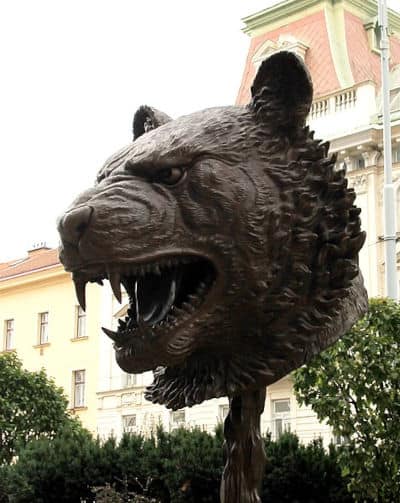
Anime and Manga
Japanese adaptations of Chinese mythology often incorporate the Four Symbols, known as the Shijin (四神), into stories that explore cosmic balance and supernatural powers:
- Yu Yu Hakusho: The Four Beasts, inspired by the Four Symbols, are powerful antagonists representing the cardinal directions and elements.
- Fushigi Yûgi (ふしぎ遊戯): The story revolves around characters representing the Four Symbols, who must summon the beasts to protect their world.
- Digimon Adventure: The Four Holy Beasts—based on the Azure Dragon, Vermilion Bird, White Tiger, and Black Turtle—act as powerful guardians of the digital world.
Video Games
The Four Symbols appear frequently in video games, especially those involving Chinese mythology, fantasy elements, or martial arts:
- Final Fantasy Series: The creatures often appear as powerful summons or bosses. For instance, Seiryu (Azure Dragon) and Suzaku (Vermilion Bird) feature as legendary beasts in various titles.
- League of Legends: Skins and characters inspired by the Four Symbols bring their mythological essence into gameplay, each representing their respective elements and roles within the game.
- Genshin Impact: This game draws heavily from Chinese culture, incorporating symbols and themes related to the Four Sacred Animals. Certain regions or characters resonate with their symbolism, particularly through elemental affinities.
Music and Art
The Four Sacred Animals are frequently depicted in traditional Chinese music and modern art installations:
- Instrumental Themes: Classical compositions often invoke the spirit of the animals, with distinct tonal shifts representing their associated seasons.
- Contemporary Art: Modern Chinese artists incorporate these animals into paintings and sculptures, reinterpreting their symbolism to reflect contemporary social themes, such as balance, strength, and resilience.
Western Media Influence
The global appeal of Chinese mythology has led to adaptations of the Four Symbols in Western media:
- Movies and TV: Films like Kung Fu Panda draw on the balance of elements and animals, indirectly referencing the mythological guardians through character traits.
- Fantasy Literature: Authors of fantasy novels often use the archetypes of the Four Symbols when designing complex magical systems or mythologies.
Through these diverse representations, the Four Sacred Animals continue to captivate audiences worldwide, embodying universal themes of balance, strength, and protection while maintaining their cultural authenticity and historical roots.
An Introduction to Chinese History & Culture (Aff.link)
Dive into China’s rich past and intriguing present! From ancient dynasties to modern powerhouses, uncover Chinese culture facts, pivotal moments, and the captivating tales that have shaped this vast nation.
Differences Between the Four Holy Beasts and the Four Symbols
While the Four Holy Beasts (四灵, Sì Líng) and the Four Symbols (四象, Sì Xiàng) may seem similar due to their shared association with mythical animals, they represent distinct concepts in Chinese mythology and culture:
1. Composition and Symbolism:
- Four Holy Beasts:
This group consists of the Dragon (龙, Lóng), Phoenix (凤, Fènghuang), Turtle (龟, Guī), and Qilin (麒麟). Each creature symbolizes auspiciousness and divine power, often representing virtues or blessings:- Dragon: Authority, power, and strength.
- Phoenix: Beauty, grace, and the union of yin and yang.
- Turtle: Longevity, stability, and wisdom.
- Qilin: Benevolence, good fortune, and the arrival of great leaders.
Together, they are regarded as omens of prosperity, peace, and protection.
- Four Symbols:
Also known as the Celestial Animals, this group includes the Azure Dragon (青龙), Vermilion Bird (朱雀), White Tiger (白虎), and Black Turtle (玄武). They represent cosmic forces, cardinal directions, seasons, and elements:- Azure Dragon: East, spring, and the wood element.
- Vermilion Bird: South, summer, and the fire element.
- White Tiger: West, autumn, and the metal element.
- Black Turtle: North, winter, and the water element.
These creatures are integral to Chinese cosmology and astronomy, symbolizing the universe’s balance.
2. Cultural Context:
- Four Holy Beasts:
Primarily appear in mythological tales and auspicious symbols for royal authority and spiritual significance. The Qilin, in particular, is linked to prophecy and the arrival of sages. They are often depicted together in imperial palaces or in ceremonial artifacts. - Four Symbols:
These play a crucial role in Feng Shui and Chinese constellations, guiding the layout of cities, homes, and even burial sites. They are connected to astrology, each governing seven of the 28 lunar mansions.
3. Representation in Art:
- Four Holy Beasts:
Frequently depicted in imperial seals, porcelain art, and temple carvings. Each beast is typically portrayed independently or paired with celestial beings. - Four Symbols:
Commonly illustrated in celestial maps, temple murals, and Feng Shui diagrams, often shown guarding their respective cardinal directions.
Final Thoughts
In conclusion, the Four Sacred Animals—Azure Dragon, Vermilion Bird, White Tiger, and Black Turtle—serve as profound symbols deeply embedded in Chinese mythology, astronomy, and culture. These celestial beings not only represent the cardinal directions and seasons but also embody key elements of balance, protection, and cosmic harmony.
Their influence extends beyond ancient texts and Feng Shui into modern business, fashion, media, and spiritual practices, resonating across global cultures. This enduring legacy highlights a universal human desire to understand natural forces and seek balance, demonstrating how ancient wisdom continues to shape contemporary life and global consciousness.
Stay in Touch
 Join our newsletter by using the forms on this website or click here!
Join our newsletter by using the forms on this website or click here! Follow us on Google News
Follow us on Google News Follow us on Facebook
Follow us on Facebook

